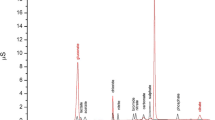Abstract
Penicillium chrysogenum contains two mevalonic acid dehydratases with different product stereospecificity. For the enzyme fromFusarium cubense which synthesizes cis-Δ2-anhydromevalonic acid, it was shown in both whole cells and cell-free extracts, that mevalonic acid is the only substrate.d-Mevalonic acid and a [U-14C]-labelled product were prepared by fermentation ofEndomycopsis fibuliger.
An enzyme fromFusarium cubense, which activates the carboxyl group of cis-Δ2-anhydromevalonic acid, was detected by the hydroxamate test. The reaction is coenzyme A-dependent and has its maximum activity at pH 7.5. The enzyme catalyses exchange of [32P]-pyrophosphate with ATP in the presence of cis-Δ2-anhydromevalonic acid.
The biosynthetic pathway of the Δ2-anhydromevalonic acids and their incorporation into sideramines from fungi is discussed.
Zusammenfassung
Penicillium chrysogenum enthält zwei Mevalonsäuredehydratasen mit unterschiedlicher Produktstereospezifität. Für das cis-Δ2-Anhydromevalonsäure-synthetisierende Enzym ausFusarium cubense wurde in ganzen Zellen und in zellfreien Extrakten nachgewiesen, daß nurd-Mevalonsäure Substrat ist.d-Mevalonsäure sowie ein [U-14C]-markiertes Präparat wurden durch Fermentation vonEndomycopsis fibuliger hergestellt. Mit dem Hydroxamsäuretest wurde ein Enzyme ausFusarium cubense, das cis-Δ2-Anhydromevalonsäure an der Carboxylgruppe aktivitrt, nachgewiesen. Die Reaktion ist Coenzym A-abhängig und hat ein pH-Optimum von 7,5. Das Enzym katalysiert in Gegenwart von cis-Δ2-Anhydromevalonsäure Austausch von [32P]-Pyrophosphat in ATP. Der Biosyntheseweg der cis-Δ2-Anhydromevalonsäuren und deren Einbau in Sideramine von Pilzen wird diskutiert.
Similar content being viewed by others
Literatur
Anke, H.: Biosynthese der cis- und trans-5-Hydroxy-3-methylpenten-(2)-säuren (Δ-Anhydromevalonsäuren) und der Einbau von cis-5-Hydroxy-3-methyl-penten-(2)-säure in Sideramine bei Pilzen. Dissertation, Universität Tübingen 1973
Anke, H., Diekmann, H.: Metabolic products of microorganisms. 93. Biosynthesis of sideramines in fungi. Mevalonate as a precursor of cis- and trans-5-hydroxy-3-methyl-2-pentenoic acids. FEBS Letters17, 115–117 (1971)
Beinert, H., Green D. E., Hele, P., Hift, H., von Korff, R. W., Ramakrishnan, C. V.: The acetate activating enzyme system of heart muscle. J. biol. Chem.203, 35–45 (1953)
Beisenherz, G., Boltze, H. J., Bücher, T., Czok, R., Garbade, K. H., Meyer-Arendt, E., Pfleiderer, G.: Diphosphofructose-Aldolase, Phosphoglyceraldehyd-Dehydrogenase, Milchsäure-Dehydrogenase, Glycerophosphat-Dehydrogenase und Pyruvat-Kinase aus Kaninchenmuskulatur in einem Arbeitsgang. Z. Naturforsch.8b, 555–577 (1953)
Berg, P.: Assay and preparation of yeast aceto-CoA kinase. In: Methods in enzymology, Vol. V, S. P. Colowick, and N. O. Kaplan, Eds., pp. 461–467. London-New York: Academic Press 1962
Calendar, R., Berg, P.: Purification and physical characterization of tyrosyl ribonucleic acid synthetases fromEscherichia coli andBacillus subtilis. Biochemistry5, 1681–1690 (1966)
Diekmann, H.: Stoffwechselprodukte von Mikroorganismen. 56. Mitt. Fusigen — ein neues Sideramin aus Pilzen. Arch. Mikrobiol.58, 1–5 (1967)
Diekmann, H.: Stoffwechselprodukte von Mikroorganismen. 68. Mitt. Die Isolierung und Darstellung von trans-5-Hydroxy-3-methylpenten-(2)-säure. Arch. Mikrobiol.62, 322–327 (1968)
Eberle, M., Arigoni, D.: Absolute Konfiguration des Mevalonactons. Helv. chim. Acta43, 1508–1513 (1960)
Eggerer, H., Lynen, F.: Zur Biosynthese der Polyisoprenoide. I. Darstellung von β-Hydroxy-β-methylglutaraldehydsäure. Justus-Liebigs Ann. Chem.608, 71–81 (1957)
Eisenberg, M. A.: The acetate-activating enzyme ofRhodospirillum rubrum. Biochim. biophys. Acta (Amst.)16, 58–65 (1955)_
Gross, G.G., Zenk, M. H.: Darstellung und Eigenschaften von Coenzym A-Thiolestern substituierter Zimtsäuren. Z. Naturforsch.21b, 683–690 (1966)
Grüner, H.: Biosynthese der Δ2-Anhydromevalonsäure und ihr Einbau in Sideramine bei Pilzen. Diplomarbeit, Universität Tübingen 1970
Hahlbrock, K., Grisebach, H.: Formation of CoA-esters of cinnamic acids with an enzyme preparation from cell suspension cultures of parsley. FEBS Letters11, 62–64 (1970)
Hanson, K. R., Rose, I. A.: The absolute stereochemical course of citric acid biosynthesis. Proc. nat. Acad. Sci. (Wash.)50, 981–988 (1963)
Jencks, W.P.: Activating enzymes for higher fatty acids. In: Methods in enzymology, Vol. V, S.P. Colowick and N.O. Kaplan, Eds., pp. 467–472. London-New York: Academic Press 1962
Lynen, F., Graßl, M.: Zur Biosynthese der Terpene. II. Darstellung von (−)-Mevalonsäure durch bakterielle Racematspaltung. Hoppe-Seyler's Z. physiol. Chem.313, 291–295 (1958)
Shunk, C. H., Linn, B. O., Huff, J. W., Gilfillan, J. L., Skeggs, H. R., Folkers, K.: Resolution ofDl-mevalonic acid and the synthesis and biological activities ofDl-3-hydroxy-3-methylglutaraldehydic acid. J. Amer. chem. Soc.79, 3294–3295 (1957)
Tamura, G., Ando, K., Kodama, K., Arima, K.: Production of mevalonic acid by fermentation. Appl. Microbiol.16, 965–972 (1968)
Walker, J. E., Otani, S., Perlman, D.: Biosynthesis of actinomycin D. Purification and properties of an enzyme which activatesl-valine. FEBS Letters20, 162–166 (1972)
Warburg, O., Christian, W.: Isolierung und Kristallisation des Gärungsferments Enolase. Biochem. Z.310, 384–421 (1941/1942)
Wolf, D. E., Hoffman, C. H., Aldrich, P. E., Skeggs, H. R., Wright, L. D., Folkers, K.: β-Hydroxy-β-methyl-δ-valerolactone (divalonic acid), a new biological factor. J. Amer. chem. Soc.78, 4499 (1956)
Author information
Authors and Affiliations
Additional information
124. Mitteilung: H. Plattner u. H. Diekmann: Stoffwechselprodukte von Mikroorganismen. Einbau vonl-Leucin in cyclo-l-Leucyl-l-leucyl, dem Intermediärprodukt der Biosynthese von Pulcherriminsäure, in zellfreien Extrakten vonCandida pulcherrima. Arch. Mikrobiol.93, 363–365 (1973).
Rights and permissions
About this article
Cite this article
Anke, H., Diekmann, H. Stoffwechselprodukte von Mikroorganismen. Arch. Microbiol. 95, 213–225 (1974). https://doi.org/10.1007/BF02451763
Received:
Issue Date:
DOI: https://doi.org/10.1007/BF02451763



